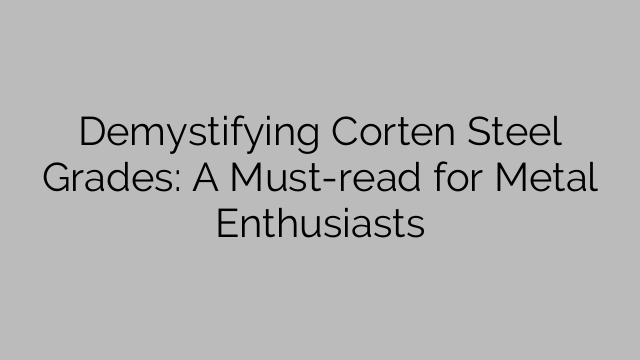To understand Corten steel grades, we must first grasp the concept of weathering steel. Developed in the 1930s, Corten steel was initially used in railway coal wagons. Over time, it found its way into various structural applications due to its exceptional weather resistance properties. The key feature of Corten steel lies in its ability to form a protective and self-healing oxide layer when exposed to the elements, significantly reducing corrosion and eliminating the need for painting.
There are several Corten steel grades, but the most commonly used ones are ASTM A588 and ASTM A242. These grades offer a balance between formability, weldability, and weather resistance. Both ASTM A588 and ASTM A242 exhibit similar corrosion-resistant properties, with slight differences in their composition.
ASTM A588 is the most popular Corten steel grade, widely recognized for its high tensile strength and corrosion resistance. It contains elements such as chromium, nickel, and copper, which enhance its weathering properties. ASTM A588 is often used in outdoor sculptures, architectural applications, and construction projects, where its distinct rusty appearance adds a touch of elegance and uniqueness.
On the other hand, ASTM A242 offers advantages in terms of its lower cost and improved formability. It is frequently used in structural applications and is often substituted for ASTM A588 in cases where aesthetics are not the primary concern. Although ASTM A242 may not develop the same rich patina as ASTM A588, it provides sufficient weather resistance for many outdoor applications.
Understanding the properties of Corten steel grades can help enthusiasts make an informed decision when selecting the right material for their projects. Architects and designers may prioritize the aesthetic aspect and opt for ASTM A588 to achieve a distinctive rusty look. Structural engineers and builders, on the other hand, might consider ASTM A242 due to its cost-effectiveness and formability.
It is worth noting that Corten steel requires exposure to the elements to fully develop its protective patina, which can take anywhere from a few months to a few years. During this time, the steel may undergo some initial rust runoff, which should be taken into account during installation and protection of adjacent materials.
In conclusion, demystifying Corten steel grades is crucial for metal enthusiasts looking to incorporate this remarkable material into their projects. Understanding the differences between ASTM A588 and ASTM A242 can guide designers, architects, engineers, and artists in making the right choice based on their specific requirements. Whether it is the unrivaled aesthetics or the excellent corrosion resistance properties, Corten steel grades undoubtedly offer a unique and appealing option for metal enthusiasts.
[ad_2]

